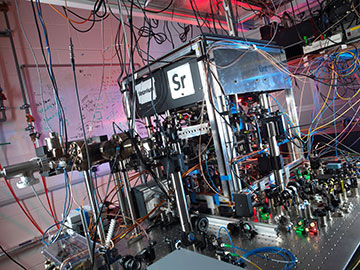![]()
Laser light with an ultrastable frequency in the ytterbium ion optical clock at NPL. [Image: Andrew Brookes]
Optical clocks provide ultraprecise frequency references that promise 100-times-greater precision and accuracy for advancing fundamental physics and international metrology. Known as the next generation of atomic clocks, these devices are poised to redefine the second for the first time in more than 50 years.
Now, an international team of researchers has completed the largest coordinated comparison of optical clocks to date, spanning 10 clocks in six different countries (Optica, doi: 10.1364/OPTICA.561754). The results inspire greater confidence in the accuracy and consistency of optical clocks and largely support the use of optical standards for international time scales.
Redefining the second
Optical clocks are a type of atomic clock that work by tuning a laser frequency to match a natural resonance frequency in an atom. The output signal from each optical clock is laser light with a very stable and accurate frequency. Several atomic clocks are available worldwide, based on different atomic species.
“We wanted to check that optical clocks in different countries agree because it is expected that these high-performance atomic clocks will soon be used for a new definition of the second in the International System of Units, as well as for underpinning international time scales,” said Rachel Godun of the optical frequency metrology group at the National Physical Laboratory, UK.
Previous work has carried out comparisons with at most only two or three optical clocks and using a single technique. Godun and her colleagues aimed for a more extended clock comparison campaign to demonstrate that systems are operating within their expected uncertainties. The redefinition of the second is targeted for 2030, and such a campaign would demonstrate the feasibility of operating a network of optical clocks.
A network of clocks

Strontium optical lattice clock at NPL. [Image: Andrew Brookes]
The researchers compared 10 optical clocks located in Finland, France, Germany, Italy, the UK and Japan over 45 days. The frequency outputs from the systems were linked together in two ways: through radio signals from satellites and optical fibers. The data were collected centrally and analyzed to build up a picture of the level of agreement between different clocks.
In total, there were 38 frequency ratios for comparison, including the first direct measurement of four frequency ratios. Many showed agreement between the clocks with significantly lower uncertainties than previously achieved. However, some measurements revealed inconsistencies, such as possible offsets, that need to be investigated further.
“Atomic clocks underpin many technologies in modern society, from synchronizing energy and telecoms networks to enabling satellite navigation and the time-stamping of financial transactions,” said Godun. “[Optical clocks] are likely to unlock completely new applications as well as advancing areas of science that rely on time and frequency signals with the utmost precision.”

